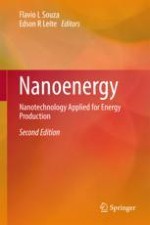2018 | OriginalPaper | Buchkapitel
Nanomaterials for Solar Energy Conversion: Dye-Sensitized Solar Cells Based on Ruthenium(II) tris-Heteroleptic Compounds or Natural Dyes
verfasst von : Juliana dos Santos de Souza, Leilane Oliveira Martins de Andrade, Andressa Vidal Müller, André Sarto Polo
Erschienen in: Nanoenergy
Aktivieren Sie unsere intelligente Suche, um passende Fachinhalte oder Patente zu finden.
Wählen Sie Textabschnitte aus um mit Künstlicher Intelligenz passenden Patente zu finden. powered by
Markieren Sie Textabschnitte, um KI-gestützt weitere passende Inhalte zu finden. powered by
